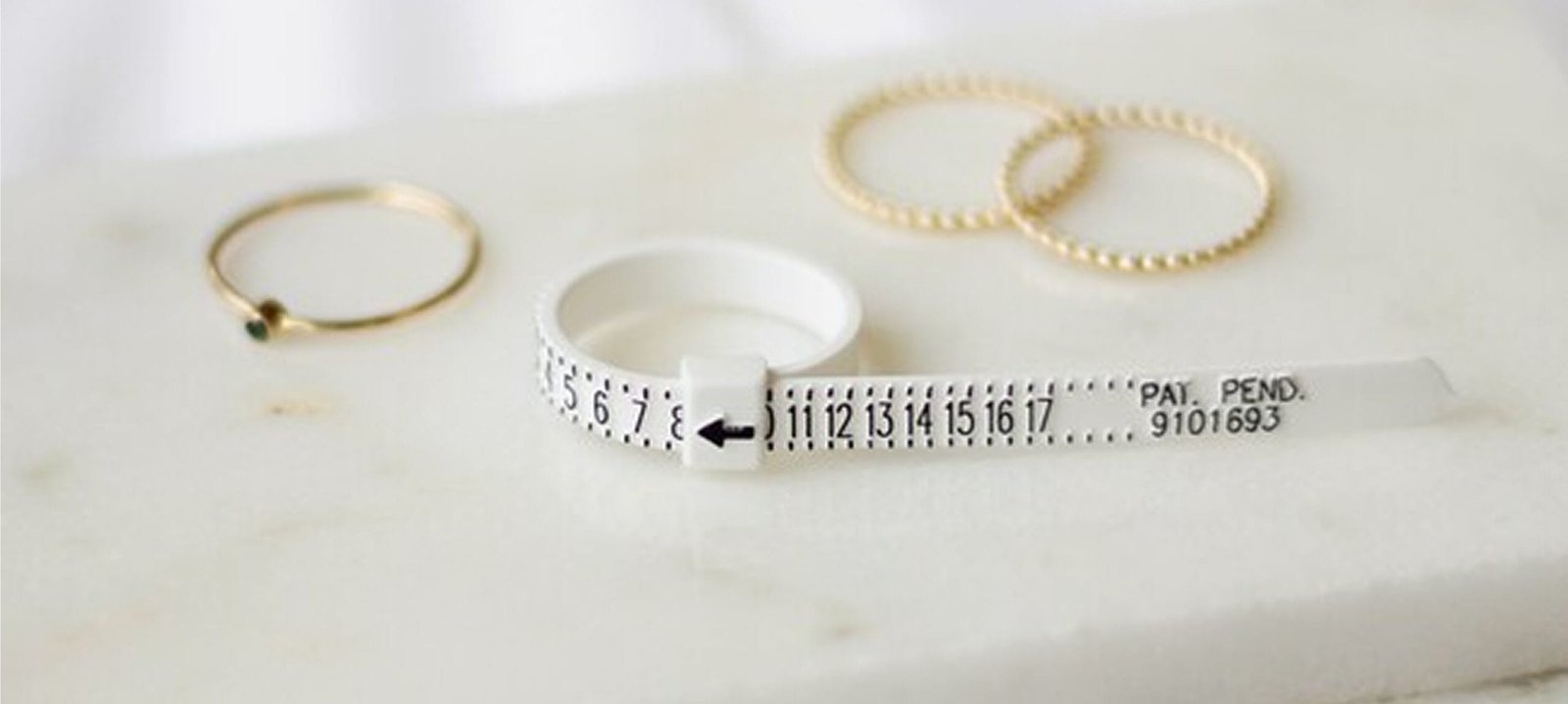


What You’ll Need:
- Printer & paper
- String, yarn, floss, or a thin strip of paper
- Pen or marker
- Ruler (preferably with millimeters)
Steps to Measure:
Cut a piece of string, yarn, floss, or paper to at least 3 inches long.
Wrap it around the base of the finger you want to size.
Mark the point where the end overlaps using a pen or marker.
Lay the string flat and measure the distance from the end to your mark in millimeters.
Match your measurement to the Ring Size Conversion Chart to find your corresponding US ring size.
Pro Tip: Measure your finger at the end of the day when it’s slightly larger, and avoid measuring when your hands are cold.
What You’ll Need:
Printer & standard 8.5 x 11-inch paper
Scissors
Steps:
- Print the Printable Ring Sizer & Conversion Chart.
Set your print scaling to 100% (do not “fit to page”) for accurate measurements.
2. Cut out the ring sizer along the outline, including the small slit indicated in the instructions.
3. Wrap the sizer snugly around the base of your intended finger, ensuring the numbers remain visible.
Insert the pointed end through the slit to form a loop.
4. Read the number that aligns with the slit opening—this is your ring size!
If the indicator falls between two sizes, consider a quarter size for a more precise fit.
What You’ll Need:
- Printer & standard 8.5 x 11″ paper
- Scissors
- An existing ring that fits the intended finger
Steps:
Print the Printable Ring Sizer & Conversion Chart.
Be sure to set your printer scaling to 100% (do not select “fit to page”) for accurate sizing.
Select a ring that fits the finger you’re sizing.
Place the ring over the circles on the chart, one at a time, until you find the circle that aligns perfectly with the inner edge of the ring.
The circle should just touch the inside of your ring without overlapping its edges.
Note the matching ring size.
If your ring falls between two sizes, feel free to contact us to request a quarter size for the most accurate fit.
The perfect ring should slide over your knuckle with light resistance and rest comfortably at the base of your finger without feeling too tight or too loose. You should be able to remove it with a gentle twist—no tugging or discomfort required.
If you find yourself between two sizes, we recommend sizing up. Finger size can fluctuate due to temperature, time of day, and activity, so a slightly larger ring offers more flexibility and comfort.
A ring that’s too tight can be difficult—and painful—to remove, while a ring that’s slightly loose can often be adjusted using at-home ring sizing solutions (like ring snuggies or sizing beads).
Still not quite right? We offer quarter sizes upon request to help you find the most precise fit. Simply contact us and we’ll craft your ideal size.
Measure the hand you’ll wear the ring on—dominant hands are usually slightly larger.
Wider bands fit tighter—size up for chunky rings, size down for very thin ones.
Measure at room temperature—cold fingers shrink, warm ones expand.
Best time to measure: late afternoon or evening.
Have large knuckles? Measure both the base and knuckle, then choose a size in between.

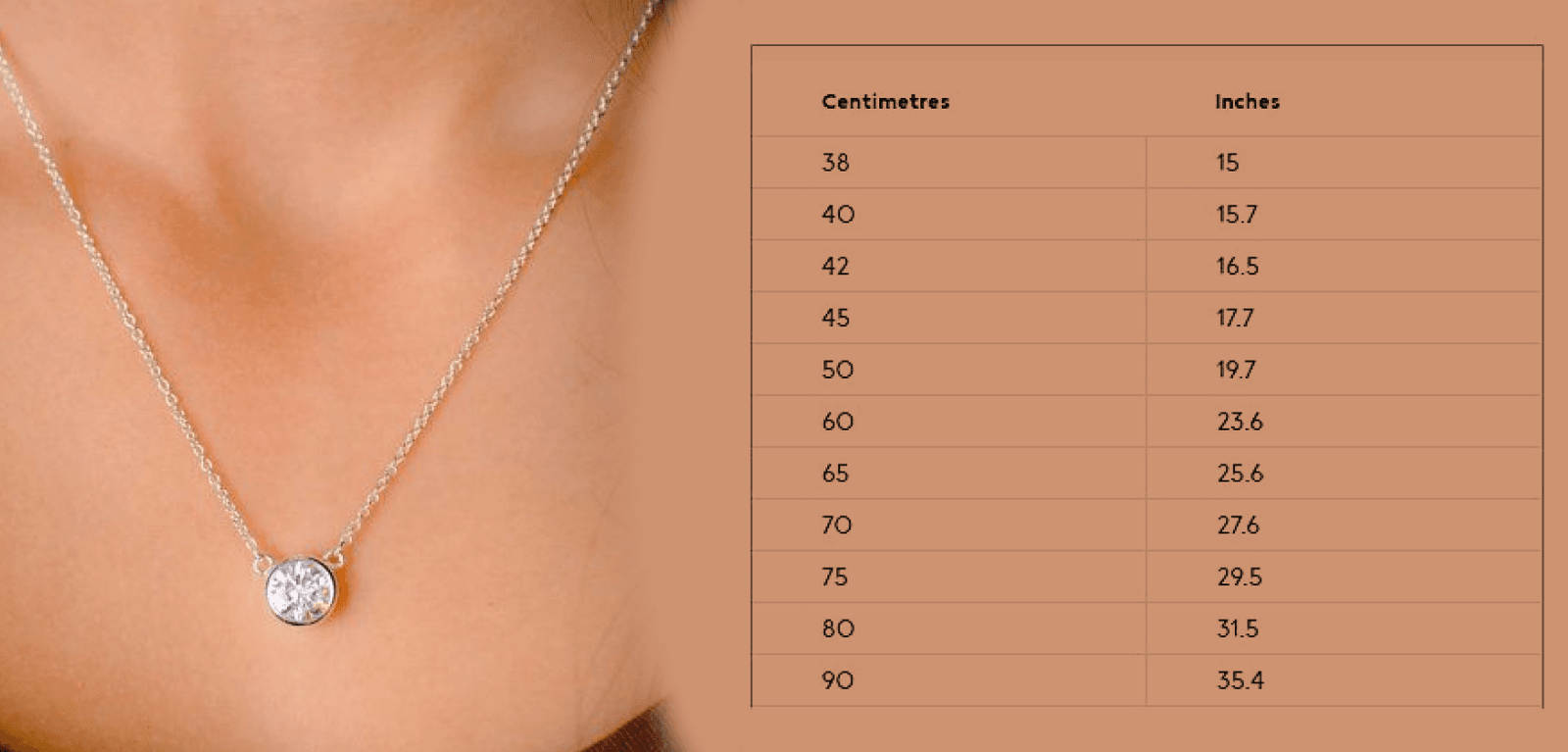
Necklace lengths can range from minimalist chokers at 14 inches to dramatic strands that extend beyond 30 inches. A classic choice is the 18-inch necklace, which typically rests gracefully at the collarbone—ideal for pendants and everyday wear. Longer styles, such as 24- to 36-inch chains, offer a more layered, statement look and are popular for both men and women.
Choosing the right necklace length is all about personal style. Do you like a piece that sits just above the collarbone? Or something that drapes lower across the chest? You might even opt to layer multiple lengths for a modern, stacked effect.
At Vega New York, we don’t categorize necklace sizes by gender. Every body is unique, and style has no boundaries. Instead, we focus on helping you understand how each length typically sits on the body—so you can make the choice that feels best for you.
Let’s break down the most common necklace sizes and how they fit.
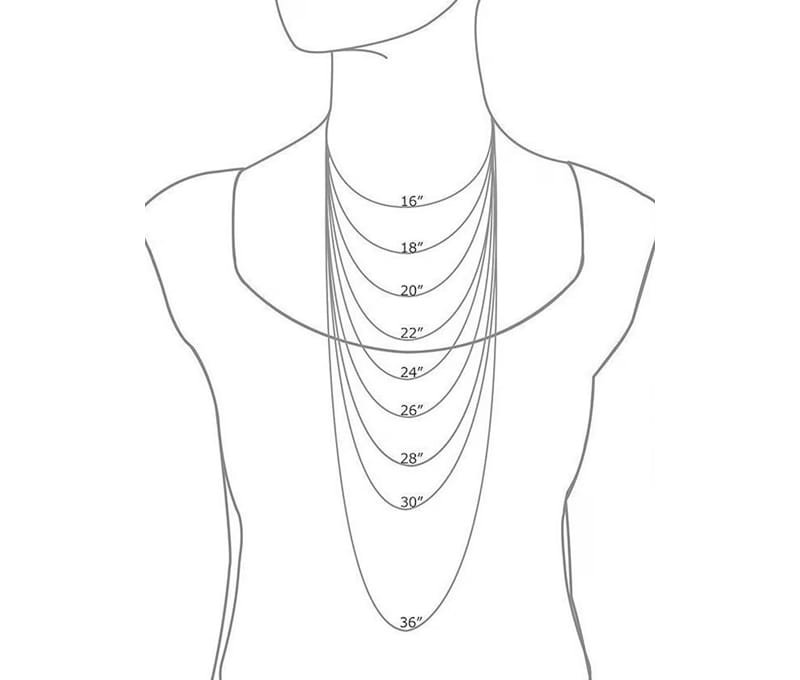
14-Inch Necklaces
Typically the shortest necklace length available for women, 14-inch chains sit closely around the neck like a choker. This trendy, statement-making style also layers beautifully with longer necklaces without tangling at the base of your neck.
16-Inch Necklaces
Resting just above the collarbone, 16-inch necklaces are the shortest non-choker option. Chic yet subtle, they work well solo or layered and offer a refined, fashionable look that’s slightly less bold than a choker.
18-Inch Necklaces
Considered the most common necklace length, 18-inch chains rest just below the clavicle. This go-to size is ideal for pendants and creates a classic, elegant silhouette—perfect for everyday wear or more dressed-up occasions.
20-Inch Necklaces
Often the shortest standard length for men, 20-inch necklaces fall one to two inches below the collarbone. This versatile length works well with high necklines, making it a popular choice for both men and women.
22-Inch Necklaces
Sitting midway between the clavicle and sternum, 22-inch necklaces strike a balance between bold and casual. For women, they often serve as a statement piece layered over clothing; for men, they’re a go-to for showcasing standout chains.
24-Inch Necklaces
Landing near the top of the ribs, 24-inch necklaces are a popular unisex length. They’re great for layering or wearing on their own and are frequently chosen for religious or sentimental pendants.
30-Inch Necklaces
Usually worn doubled up, 30-inch necklaces fall to the stomach if left as a single strand. They offer flexible styling—wear them long or wrap them once for a layered look with visual interest.
36-Inch Necklaces
Among the longest standard lengths, 36-inch necklaces can reach below the belly button. They’re most often worn doubled for dramatic, layered styles and make a bold statement whether worn alone or stacked.
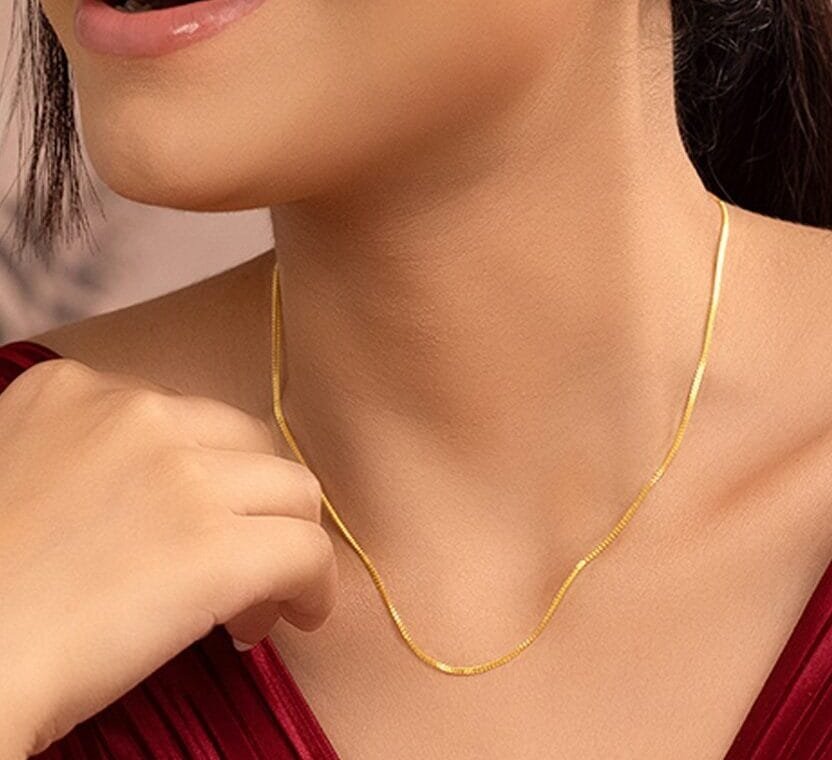
When choosing the perfect necklace, it’s not just about the style—it’s also about how it fits your unique body and complements your outfit. Here are a few key factors to keep in mind:
Height
Your height can influence how a necklace length appears on your body.
Average or tall heights: Most standard lengths will suit you well. However, very short chains may appear proportionally higher on taller frames.
Petite frames: Extra-long necklaces can hang lower than intended, so opt for mid-length chains for a more balanced look.
Neck Size
Neck circumference affects how necklaces fall.
Slim necks: Chains may hang slightly lower than standard. A 16″ necklace might look like an 18″ on a narrower neck.
Fuller necks: Short chains can sit higher or feel tight. Consider sizing up for comfort and to achieve your desired drape.
1. Outfit & Styling
Your clothing and personal style play a huge role in necklace selection.
Low necklines or plunging tops: Pair with longer necklaces (22″+) to fill the open space stylishly.
High necklines or flowy blouses: Longer chains or statement pendants can create a bold, elongating effect.
2. Layering is in.
Layering different lengths, metals, and chain styles is one of the most popular ways to personalize your look.
Classic stack combo: Try 16″, 18″, and 20″ necklaces together—close enough to complement each other without overlapping.
Mix metals: Pair silver and gold chains for a modern, edgy contrast.
Play with widths: Combine a delicate 14″ minimalist chain with a bold 16″ statement necklace for a dynamic, fashion-forward stack.
There are a couple of simple ways to determine your ideal necklace length:
1. Measure an Existing Necklace
If you already own a necklace that fits just the way you like, use it as a reference. Lay it flat on a surface and use a tape measure or a piece of string to measure its full length end-to-end. This is a reliable method for choosing a similar length for your next piece.
2. Measure Your Neck with a Tape or String
Don’t have a favorite necklace on hand? No problem.
Use a flexible measuring tape and wrap it around your neck like a necklace. Adjust it to where you want the chain to rest, then record the measurement.
If you don’t have a tape measure, use a string instead. Wrap it around your neck, mark your desired length, then lay it flat and measure it against a ruler or standard tape measure.
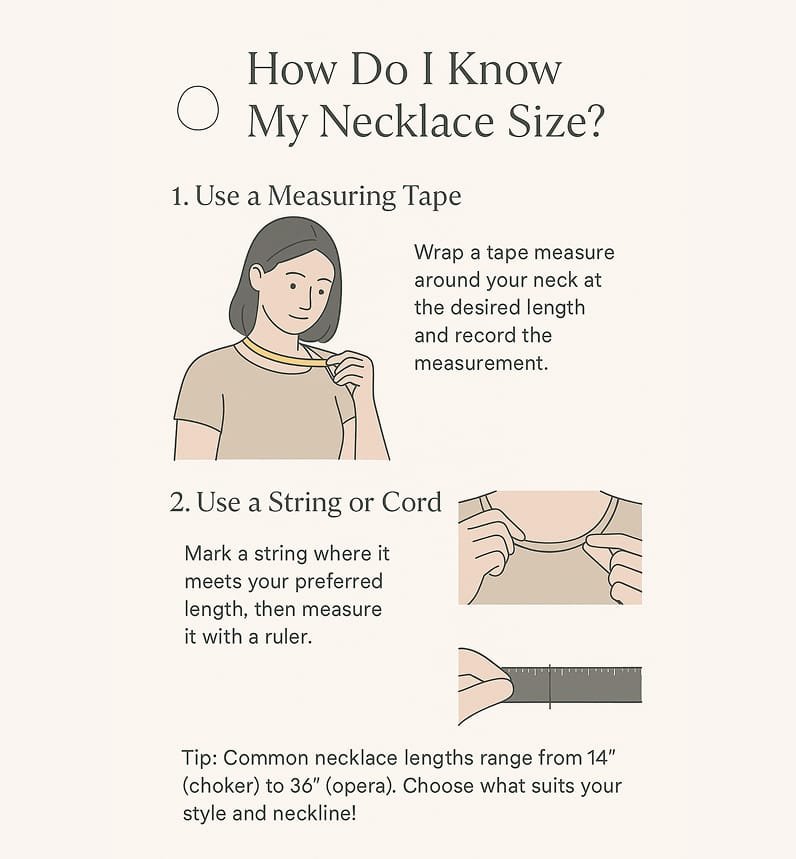
Necklace lengths for women typically range from 16 to 20 inches, with 18 inches being the most popular. This length usually sits just below the collarbone and works well with most necklines.
That said, how a necklace fits depends on your individual proportions—neck size, torso length, and personal style all play a role. Use the methods above to find a length that feels comfortable and looks just right on you
In Conclusion
The best necklace length is the one that fits your style, suits your body, and feels just right for the day. Standard lengths make it easy to shop, but your personal measurements and preferences matter most. Try out a few lengths using a string or measuring tape, or visit a jeweler to test them in person. There’s no one-size-fits-all—just what fits you best.
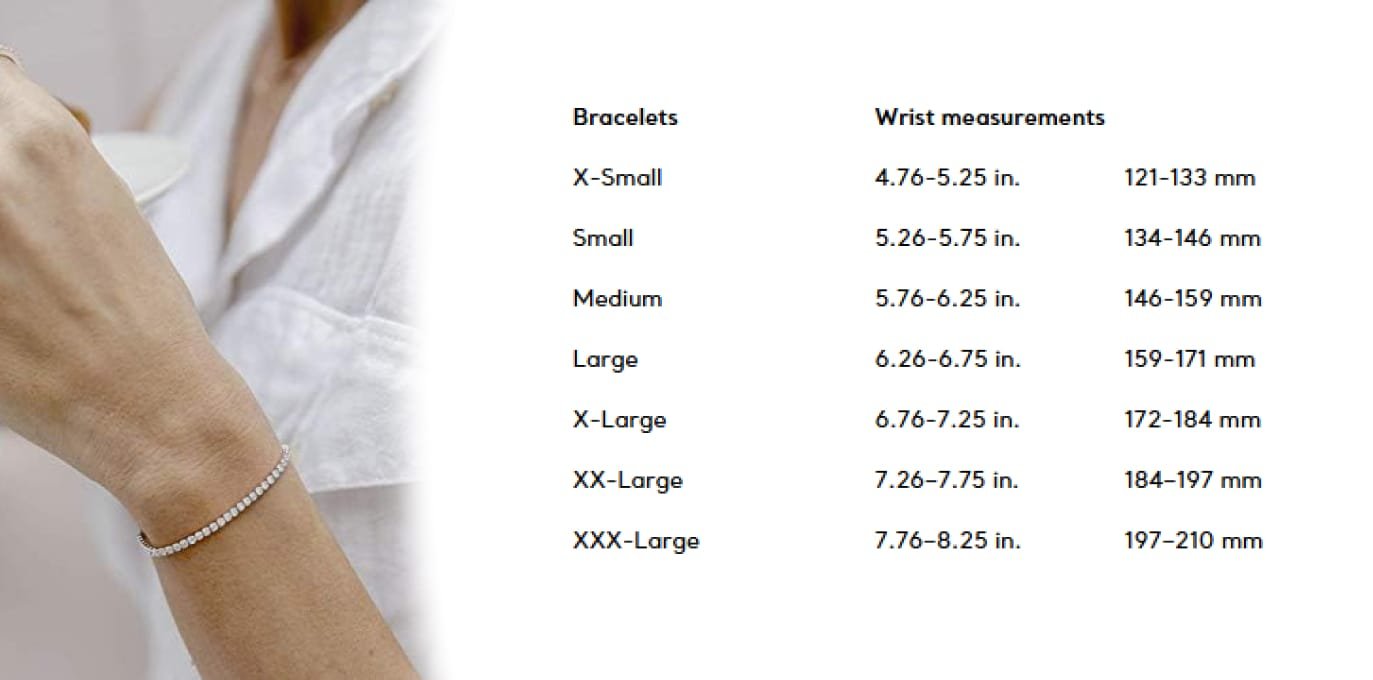
It’s All in the Wrist
1. Grab a tape measure, length of string or strip of paper.
2. Wrap it around the wrist you’ll wear your bracelet on. Mark the place where it joins. Creating a stack? Measure where on your arm you’ll wear each bracelet.
3. Lay your string or paper strip on a flat surface and use a ruler to measure the length up to the mark. Refer to the Tiffany size chart above.








